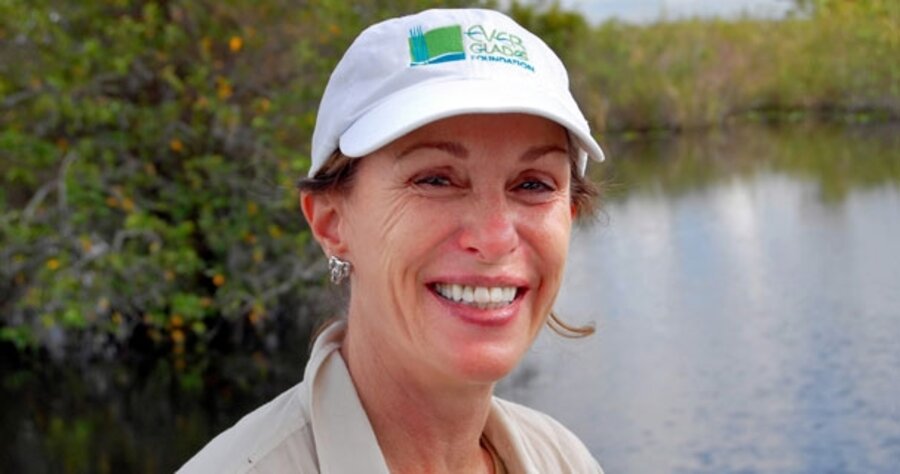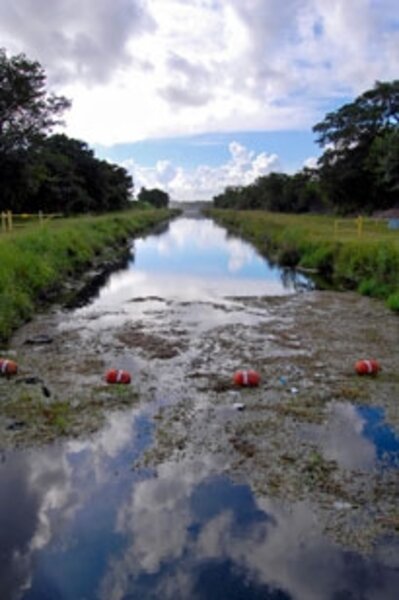Mary Barley crusades behind the scenes for the Everglades
Loading...
| Everglades National Park, Fla.
Mary Barley pauses and points into the brush. There, perched near the water, is a green heron. She reaches for her camera. On the boardwalk nearby, tourists swat mosquitoes. A small alligator floats in the distance. Somewhere pumps deliver the water that makes this entire scene possible.
It is a warm, bright morning here in the Royal Palm area of Everglades National Park, the first area of the Everglades to be preserved as a state park in 1916. Here North America meets the tropics, breeding a biodiversity unlike that of any place else on Earth. And the most valued resource is water. Water fuels the region.
Ms. Barley and I are here with Tom Van Lent, senior scientist for the Everglades Foundation, a conservation group. Barley, the foundation’s vice chairwoman, is on one of her many fact-finding trips into the Everglades. She peppers Mr. Van Lent with questions as if she’s cross-examining a witness – about water flows, about man-made water “gates,” about the minute mechanics of one of the world’s most unusual pieces of outdoor plumbing. She wants to do more than preserve the Everglades with a photograph.
For more than a decade, Barley has waged a campaign to save the Everglades, one unprecedented for engaging all the region’s power players (some of them grudgingly, to be sure) to work for real change across a collapsing ecosystem. A self-described “environmental rabblerouser,” Barley is a millionaire widow who took up her husband’s cause after his death in a 1995 plane crash that occurred as he was on his way to meet with the US Army Corps of Engineers about the Everglades.
The next year Barley faced off with the region’s potent sugar industry herself, helping win a state constitutional amendment requiring polluters to bear the brunt of cleanup costs. In 2000, she was there when President Clinton committed to an $8 billion restoration effort. Two years later, frustrated by the candidates for commissioner of the state Department of Agriculture and Consumer Services, she ran herself, but lost.
And she was there again this June when Gov. Charlie Crist announced the state would buy US Sugar in a bold $1.75 billion plan to restore a more natural water flow in the region. Environmentalists hailed the deal as historic. Barley, as usual, was at the center of it.
“She has single-handedly shifted the balance of power in Tallahassee more in favor of the Everglades,” says Eric Draper, policy director for Audubon Florida.
•••
At first Barley suspected foul play in her husband’s death. The crash killed both him and his pilot. An investigation concluded pilot error and a faulty plane part were to blame, but Barley was spooked by warnings from well-placed friends who said her husband’s political foes were capable of such a crime. She hired attorneys who conducted their own investigation, but turning up nothing.
“Could they have? Yes. But I think it’s highly unlikely,” Barley says today. We are talking in her home office in the Florida Keys. Outside, her fishing boat floats in Barley Basin. Just beyond is Florida Bay and Everglades National Park.
Barley is not your typical environmentalist. As soon as we sit down to talk, she hands me a disposable plastic bottle of water. “Would I go and sit on top of a tree?” she asks. “Probably not because I know I could be more effective doing other things.” Instead she wields influence through her wealth and well-placed friends. Her manner is direct, no-nonsense, and relentless.
In 1993 her husband, a wealthy real estate developer, established the Everglades Foundation with his friend Paul Tudor Jones, a Wall Street investor. They were motivated by the deterioration of Florida Bay, one of their favorite fishing spots, and felt they could make a difference with their money and connections.
Like her husband, Mary Barley is very data-driven and believes in fighting falsehoods with facts, and the foundation is a go-to organization for Everglades research and funding. In 2007 it disbursed $1.3 million to groups such as the Sierra Club and World Wildlife Fund.
Barley also is close to state leaders. When Mr. Crist announced the sugar deal in June, it was news to almost everyone except Barley and the foundation, which had been involved in the talks for months. She knows how to play politics and is president of the foundation’s sister organization, the Everglades Trust, which handles lobbying in Washington and Tallahassee.
With a net worth of more than $2.4 million, Barley estimates she will give perhaps “tens of thousands” this election year alone on behalf of Everglades advocacy. To her, it is fighting money with money, the best and most direct way to counter the well-funded agriculture and development industries, all of which vie for the precious water of the “river of grass.”
•••
The 5 foot, 1 inch Barley grew up in tiny Oconto, Wis., one of five children. Her dad split when she was young, and her mother raised the family with government assistance. Barley went to work when she was 7 picking beans. Today she lives with a housekeeper, two dogs and two parrots in a 2,000-square-foot waterfront home in Islamorada. Her guesthouse is 1,000 square feet. She has traveled the world.
Her campaign is about saving the Everglades but also about holding government accountable. She and her husband liked to fish together, and in the beginning their cause was the environment. Over time they became infuriated by what they saw as government corruption allowing agriculture and the development industry to rule at the expense of the ecosystem.
“It’s so hard as an American to take off your rose-colored glasses and really see it as it really is,” Barley says. “The government is run by special interests and big contributions, and the bigger contributions you give, the more likely you are to get what you need, or what you want.”
Not surprisingly, Barley’s foes – of whom there are a significant number – see things differently. Some rural farmers and sugar industry officials consider her views too overwrought and her tactics too uncompromising.
“About the best thing I could probably say about her is she’s a worthy foe,” says Rick Roth, a member of the board of directors of the Sugar Cane Growers Cooperative of Florida, who operates a family-owned farm in Belle Glade. He believes new technology has made sugar among the cleanest crops to grow. “Farmers have evolved and become more environmentally sensitive. They’ve become a lot more in tune with it as the whole nation has.”
What set the Barleys apart, at least in the beginning, was their willingness to look beyond their backyard to the Everglades as a whole, says Van Lent, who has studied the region for 25 years. A resident of Key Largo, he describes the couple as heroes for Florida Keys residents, people who finally stood up for the small fishing towns here.
“Before this everybody sort of had this little patch, and they would fight for that over every other patch,” he says. “Mary and George were the first to say the whole thing is broken, and they had the science to back it up.”
For Mary Barley, the Everglades is a full-time job. She has nothing to gain from her advocacy – except better fishing in Florida Bay – and lives off her investments. She is motivated by a sense of responsibility to the region, her husband, and the state of Florida, which she feels has given her so much.
During downtime in the Everglades, usually spent fishing, she soaks in the solitude and the open water surrounding her.
“Sometimes I think in profound ways about why it is so hard to get people to want to help, and why don’t they understand,” she says. “If we can save this place, we probably can save any place. It’s just our political will.”






